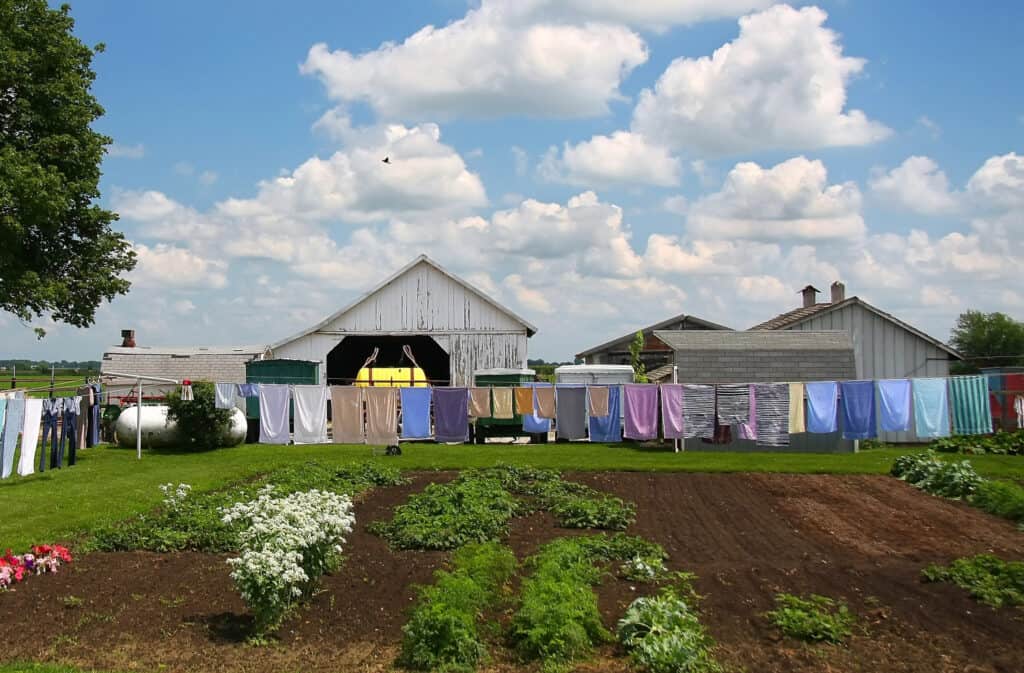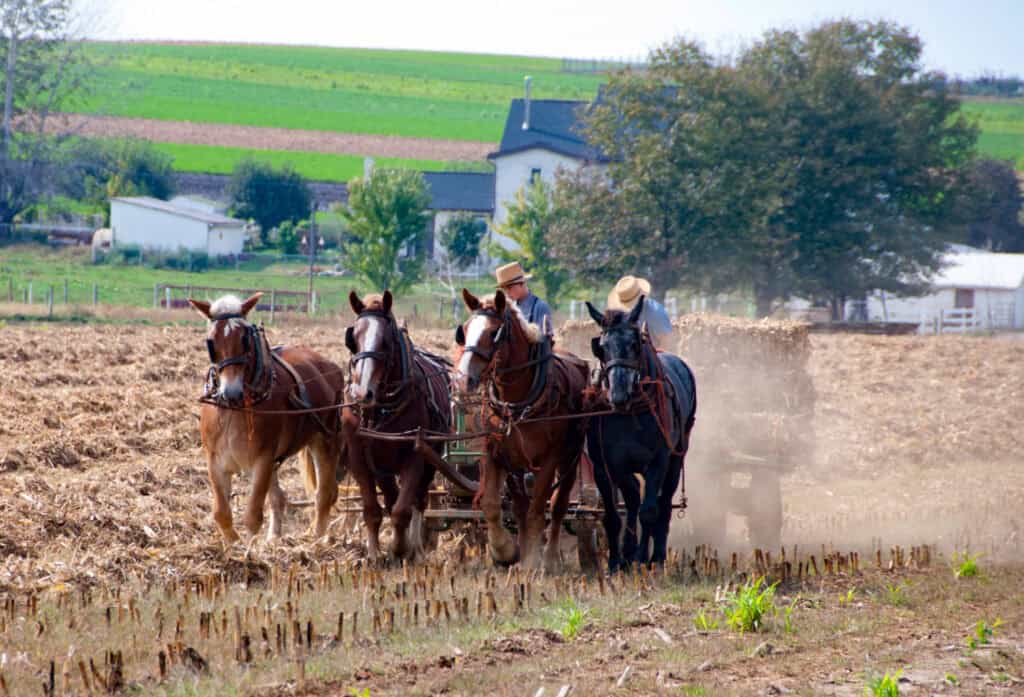Amish daily schedule
Get a peek at an Amish daily schedule to see how they are able to get so much done living an old-fashioned way of life. Being productive when you have a homestead can seem tricky. So much needs our attention that the days are often over before we know it. Todays list will have you back on track before you know it!
This helpful list is full of tips from folks living a simple life without the help of modern conveniences.

Where we live, there are all walks of life, which is unique for a rural area. One group that brings more curiosity than the others is the Amish. It is not unusual to drive past an Amish home any time of the year and see clothes on the line, families working outside, and rugs lying over the front porch railing.
The Amish are a very productive group of people, and I love to find tips and examples of how they work through their days so I can share them with others.
The Amish community is often seen as people with a good work ethic and a strong sense of community. They typically avoid (or shun) modern conveniences such as electricity, automobiles, and phones, to name a few.

The Amish are mainly farmers, craftsmen, artists, and bakers, and oftentimes, folks are curious about their ability to lead highly productive, organized, and efficient lives without the aid of modern technology.
Their everyday tasks, whether that be feeding the chickens, working in the garden, or building a new shelter for their goats are done with a sense of devotion and focus.
Their productivity is not based on stress or urgency but instead on the value and belief of hard work and community. I think that is why so many outsiders are fascinated with how they live. They seem less rushed yet able to get much more done in a day.
Almost Amish: One Woman’s Quest for a Slower, Simpler, More Sustainable Life

A look at an Amish Daily Schedule
If you want to have more productive days without running yourself ragged, this example of a daily plan, as seen through the eyes of the Amish, may be helpful and inspire you to make a few small yet life-altering changes.
The Early Morning Start
The Amish like to get up early, like really, really early, oftentimes well before dawn. This is based on the old farming tradition of ‘making hay while the sun shines.’
Starting the day early allows them to take full advantage of the daylight hours, maximizing their productivity.

Why do the Amish get up so early?
There are many reasons why the Amish like to get up early, mainly so they can take advantage of as many daylight hours as they can. Since they do not use electric lighting, daylight is a valuable tool, and they do their best to use it wisely. Here are a few more reasons:
- Getting up early encourages better sleep and overall healthier well-being.
- Mornings are quiet and peaceful, providing a perfect time for planning the day ahead.
- Early rising provides extra hours for work, allowing the Amish to accomplish more tasks, whether it’s farming, crafting, or household chores.
Getting up early is a core Amish belief that shows the value of their industry, hard work, and ability to lead organized and productive lives.
Morning Routine of the Amish
The morning is an important part of the Amish daily schedule and for good reason. An early start is a great way to begin the day on a relaxed pace without feeling rushed. Here is a typical outline of how their morning plays out.
Before Breakfast:
After waking, they often begin their day with prayer or reading, setting the tone for the day ahead. Next, they get dressed and neaten up their room.
This is followed by chores, and what is done will differ with each family.
- Women and older girls will make breakfast and pack lunches.
- Husbands and children will tend to any animals.
Breakfast Prep
The Amish are known for their hearty, homemade meals, and breakfast is no exception. It often includes farm-fresh eggs, home-cured bacon, fresh fruits, and homemade bread.
Cooking is performed on wood or gas stoves, and food is commonly, but not always, prepared from scratch. This shows how the Amish value self-reliance and sustainability.
After Breakfast
After breakfast, men will head to their jobs, children to school, and the women will stay at home to tend to the house and garden.
Everyone in the family, from the youngest to the oldest, contributes in their own way.

Typical Amish Work Day
A typical Amish workday will depend on who the person is and what their main role is with the family.
In the home
The care and upkeep of the home is the responsibility of the adult women living within the home. Their list is very similar to ours, but I do find they tend to be more consistent with cleaning and other chores.
This is probably a tip we should consider incorporating into our own schedules. Doing light cleaning each day is more efficient than doing heavy cleaning once a week.
- Prepping for lunch and dinner
- Doing the day’s baking
- Cleaning the home
- Changing linens if needed
- Doing laundry. The Amish usually do laundry a few days each week as it is more time-consuming without modern conveniences. Since they do not have dryers, all of their clothes need to line dry, which can take longer depending on the weather.

The Family Trade
The main part of the day is spent on the family profession. This can be farming, a family business, a small store, or other trade.
Farming
If the family’s profession is farming, the grown men are usually in charge of this area with the women helping out in more minor roles such as gardening or tending the chickens.
- Planting and harvesting crops
- Taking care of livestock
- Dairy
- Maintaining farm equipment
- Chickens
- Gardening
- Canning and preserving produce
- Selling food wares at local markets
Their farming methods are often traditional since most modern machinery is prohibited. It is common for horses working a pasture or manual push mowers to cut grass.

Other TRade
Recently, farming has become less profitable, pushing the Amish to find other ways to generate an income to help support their families.
- Selling their farm produce at a farmer market or road side stand.
- Selling furniture or handicrafts in a family-owned store or directly to a larger shop.
- Running local Amish-owned stores, restaurants, or bakeries
- Providing services such as construction.
Craftwork
If crafts are the main business, the bulk of the day will be spent on building, sewing, or making things to sell.
- Making furniture
- Basket weaving
- Flower crafts
- Quilting
- Blacksmithing
- Iron work
- Food crafts such as breads, cookies, or pies
I love to purchase Amish-made items mainly because their attention to detail and quality is easy to see in each craft.
Afternoon Break
The one thing that stands out among the Amish is taking breaks together as a group. This is an area we tend to skip over completely, feeling it would cause us to fall behind. The irony is that breaks help to make the Amish more productive and not less.
- Adults may spend this time reading religious scriptures or indulging in light conversation with family and neighbors.
- For children, afternoon break often means playtime like outdoor games such as volleyball or kickball.
- Depending on the season, families might do group activities like apple picking, canning, quilting, or simply sitting on the porch together.
I remember the year we had the Amish replace the roof on our home. Since we have a larger home, this was a huge job to tackle. The crew was a small one and they took a morning break of 20 minutes as well as an afternoon break of 30 minutes for lunch.
Even though they took rest periods, they still completed our roof in record time. My husband and I were shocked at their speed and skill.

Evening Tasks
As the day ends, the Amish tend to slow down their pace, incorporating fellowship with each other as they close down tasks and chores.
Dinner Prep
Preparing dinner is often a family event, with most everyone chipping in to help.
They prepare simple, hearty meals from scratch, using produce harvested from their own gardens or farms. Family dinners are a time for talking and catching up from a good, productive day.
After Dinner
the Amish finish the day by taking care of evening chores in the barn, making a full dinner, and enjoying it as a family.
- Feeding and watering livestock
- Milking cows
- Ensuring all animals are safely housed for the night.
- Cleaning up after dinner
- Washing dishes
Ending the day with relaxed chores and conversation with each other is an important part of the Amish day. Many times, we run from morning until bed, and their purposeful slowdown allows both their bodies and their brains to better prepare for rest.
Before Bed
This time is spent on easy tasks, prayer, reading, or quiet reflection.
- Mending clothes
- Repairing tools that may have been broken during the day
- Prayer as a family
- Spending time reading or quiet contemplation
Productivity Tips From The Amish
The Amish do things a bit differently than we do, and it’s those approaches that help them to be more productive.
#1. Less Stuff
The Amish tend to have neat and tidy homes mainly because they own less stuff. The like to have what they need without having more than is necessary. This is an important lesson I have noticed often. Over abundance allows them to clean more quickly freeing up so much more time throughout their day.
Lesson learned: Own less and free up more time doing things you enjoy.
#2. Fewer Distractions
Another thing is there are little to no distractions with the Amish. This allows them to keep their focus on the job at hand, helping them complete tasks in a fraction of the time it would take us.
Lesson learned: Keep the phone away while working on chores and tasks and get things done more quickly and with fewer mistakes.
#3. Self Sufficient
The Amish like to make what they need rather than purchase. This allows them to keep their skills has craftsman top quality. It also helps them to rely less on the stores and spend less by doing so.
Lesson learned: Make more and buy less so you can save more and spend less.

#4. Community
The Amish love to get help by reaching out to others within their community. This includes constructing a new building, bartering excess for where they are short, and raising money for a community member in need.
Lesson learned: Community is an important part of a thriving and happy member.
#5. Family Stays Close
Finally, the Amish are known for caring for their family throughout their lives. It is not uncommon to see aged parents and married children living under one roof. This can help the family thrive, as many hands are there to help with the work both inside and outside of the home.
Lesson learned: Family raises family from birth to death.
The Amish lifestyle, though different from ours offers lessons we can all learn from. By focusing on simplicity, hard work, and close family bonds, they have a balanced and grounded life. By adopting a few of these aspects we can create a routine that still incorporates modern conveniences yet gives us a more centered daily plan to follow.
This Amish daily schedule example urges us to fill our lives with deliberation and mindfulness, taking us out of autopilot and helping us to be more involved in each moment, no matter how small.



